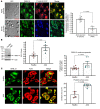Platelet olfactory receptor activation limits platelet reactivity and growth of aortic aneurysms
- PMID: 35324479
- PMCID: PMC9057618
- DOI: 10.1172/JCI152373
Platelet olfactory receptor activation limits platelet reactivity and growth of aortic aneurysms
Abstract
As blood transitions from steady laminar flow (S-flow) in healthy arteries to disturbed flow (D-flow) in aneurysmal arteries, platelets are subjected to external forces. Biomechanical platelet activation is incompletely understood and is a potential mechanism behind antiplatelet medication resistance. Although it has been demonstrated that antiplatelet drugs suppress the growth of abdominal aortic aneurysms (AAA) in patients, we found that a certain degree of platelet reactivity persisted in spite of aspirin therapy, urging us to consider additional antiplatelet therapeutic targets. Transcriptomic profiling of platelets from patients with AAA revealed upregulation of a signal transduction pathway common to olfactory receptors, and this was explored as a mediator of AAA progression. Healthy platelets subjected to D-flow ex vivo, platelets from patients with AAA, and platelets in murine models of AAA demonstrated increased membrane olfactory receptor 2L13 (OR2L13) expression. A drug screen identified a molecule activating platelet OR2L13, which limited both biochemical and biomechanical platelet activation as well as AAA growth. This observation was further supported by selective deletion of the OR2L13 ortholog in a murine model of AAA that accelerated aortic aneurysm growth and rupture. These studies revealed that olfactory receptors regulate platelet activation in AAA and aneurysmal progression through platelet-derived mediators of aortic remodeling.
Keywords: Platelets; Signal transduction; Thrombosis; Vascular Biology.
Figures











Similar articles
-
Targeting Platelet Activation in Abdominal Aortic Aneurysm: Current Knowledge and Perspectives.Biomolecules. 2022 Jan 25;12(2):206. doi: 10.3390/biom12020206. Biomolecules. 2022. PMID: 35204706 Free PMC article. Review.
-
Effect of blocking platelet activation with AZD6140 on development of abdominal aortic aneurysm in a rat aneurysmal model.J Vasc Surg. 2009 Mar;49(3):719-27. doi: 10.1016/j.jvs.2008.09.057. Epub 2008 Nov 22. J Vasc Surg. 2009. PMID: 19028049
-
[Platelet accumulation in abdominal aortic aneurysms and the effect of antiplatelet drugs: assessment by indium platelet scintigraphy].Kaku Igaku. 1992 Jun;29(6):651-7. Kaku Igaku. 1992. PMID: 1640649 Japanese.
-
Clopidogrel, a platelet P2Y12 receptor inhibitor, reduces vascular inflammation and angiotensin II induced-abdominal aortic aneurysm progression.PLoS One. 2012;7(12):e51707. doi: 10.1371/journal.pone.0051707. Epub 2012 Dec 20. PLoS One. 2012. PMID: 23284748 Free PMC article.
-
Lack of an effective drug therapy for abdominal aortic aneurysm.J Intern Med. 2020 Jul;288(1):6-22. doi: 10.1111/joim.12958. Epub 2019 Jul 29. J Intern Med. 2020. PMID: 31278799 Review.
Cited by
-
Cellular and enzymatic features of thrombi in humans are vascular bed dependent.Blood Vessel Thromb Hemost. 2024 Sep 23;2(1):100029. doi: 10.1016/j.bvth.2024.100029. eCollection 2025 Feb. Blood Vessel Thromb Hemost. 2024. PMID: 40766874 Free PMC article.
-
A Divergent Platelet Transcriptome in Patients with Lipedema and Lymphedema.Genes (Basel). 2024 Jun 4;15(6):737. doi: 10.3390/genes15060737. Genes (Basel). 2024. PMID: 38927673 Free PMC article.
-
Antiplatelet Therapy, Abdominal Aortic Aneurysm Progression, and Clinical Outcomes.JAMA Netw Open. 2023 Dec 1;6(12):e2347296. doi: 10.1001/jamanetworkopen.2023.47296. JAMA Netw Open. 2023. PMID: 38085542 Free PMC article.
-
Characterization of small abdominal aortic aneurysms' growth status using spatial pattern analysis of aneurismal hemodynamics.Sci Rep. 2023 Aug 24;13(1):13832. doi: 10.1038/s41598-023-40139-z. Sci Rep. 2023. PMID: 37620387 Free PMC article.
-
Platelet pals: How blood cells shape the future of the aorta.Vasc Med. 2025 Feb;30(1):48-49. doi: 10.1177/1358863X241309832. Epub 2025 Jan 1. Vasc Med. 2025. PMID: 39743763 Free PMC article. No abstract available.
References
Publication types
MeSH terms
Substances
Grants and funding
LinkOut - more resources
Full Text Sources
Medical
Molecular Biology Databases
Research Materials

